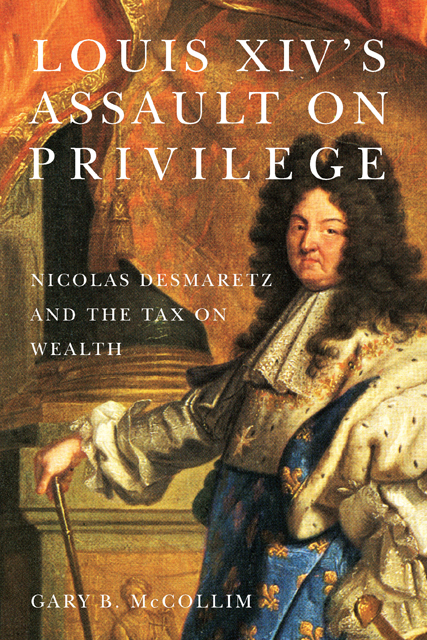Book contents
- Frontmatter
- Dedication
- Contents
- List of Illustrations
- Preface
- List of Abbreviations
- Introduction
- 1 The Fiscal System under Louis XIV
- 2 The Rise of the Administrative Monarchy
- 3 Nicolas Desmaretz and Company
- 4 Handling Ideas for Reform
- 5 The Establishment of the Dixième
- 6 After the Dixième
- Conclusion
- Appendix 1 The Conseil d’en haut, or the Council of Ministers
- Appendix 2 Members of the Royal Council of Finances under Louis XIV
- Appendix 3 Controllers General, Directors, and Intendants of Finances
- Appendix 4 Glossary of Terms
- Notes
- Bibliography
- Index
5 - The Establishment of the Dixième
Published online by Cambridge University Press: 14 February 2023
- Frontmatter
- Dedication
- Contents
- List of Illustrations
- Preface
- List of Abbreviations
- Introduction
- 1 The Fiscal System under Louis XIV
- 2 The Rise of the Administrative Monarchy
- 3 Nicolas Desmaretz and Company
- 4 Handling Ideas for Reform
- 5 The Establishment of the Dixième
- 6 After the Dixième
- Conclusion
- Appendix 1 The Conseil d’en haut, or the Council of Ministers
- Appendix 2 Members of the Royal Council of Finances under Louis XIV
- Appendix 3 Controllers General, Directors, and Intendants of Finances
- Appendix 4 Glossary of Terms
- Notes
- Bibliography
- Index
Summary
When Nicolas Desmaretz became controller general of finances in February 1708, he found the royal finances in great disarray. Almost twenty years of expedients and war had dilapidated a credit system based on indirect taxation, the kind that most immediately suffered the repercussions of war. Like Pontchartrain in 1689, Desmaretz did not have time to prepare for new ways to finance France’s war effort. He had to find funds to support the campaign of 1708 and to establish credit for future campaigns until peace was restored.
One of his first acts was to restore liberté dans les conventions (liberty to make agreements) among businessmen. An arrêt of October 29, 1707, which required that all payments be made with a mixture of paper and coin that included at least one quarter in mint bills, had restricted their freedom. This restriction was an effort to maintain the credit of royal paper that had upset commercial exchanges. An arrêt of February 25, 1708, allowed both buyers and sellers in large-scale business arrangements to set their own terms for payment.
Desmaretz launched a series of complicated measures to attract the confidence of the business and investing community. He ordered that all money owed to the royal government be paid to the Royal Treasury rather than diverted to pay other expenses, a practice his predecessor had encouraged. When he centralized the collection of royal funds, a policy that had to be reinforced by other measures, Desmaretz was trying to give the controller general greater authority over the flow of revenue by enabling efforts to enforce the regularity with which comptables paid their debts to the Royal Treasury. Desmaretz wanted to end the unnecessary delays in repaying loans that the state’s creditors had to endure, to establish priorities as to which payments should be made first, and to restore credit to the Royal Treasury by having large sums of money flow through it.
Restoring credit was necessary in order to reduce the difference between the face value and negotiable value of royal paper. Desmaretz, whom many people in the business community apparently trusted (given the delight they expressed at his appointment), used his contacts within the financial community to persuade those who held assignations against the revenue for the year 1708 to turn them in for assignations against future revenue.
- Type
- Chapter
- Information
- Louis XIV's Assault on PrivilegeNicolas Desmaretz and the Tax on Wealth, pp. 160 - 193Publisher: Boydell & BrewerPrint publication year: 2012

